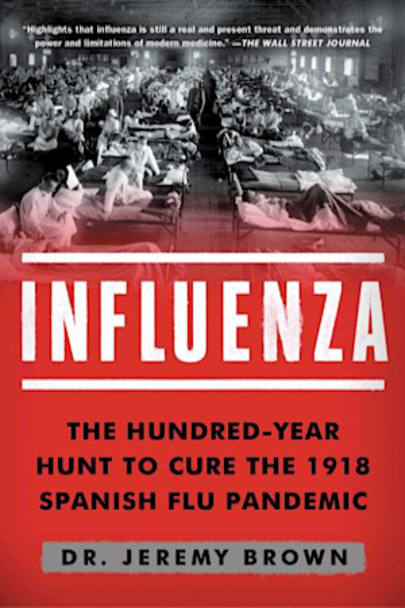“Highlights that influenza is still a real and present threat and demonstrates the power and limitations of modern medicine.” –The Wall Street Journal “A surprisingly compelling and accessible story of one of the world’s most deadly diseases. It is timely and interesting, engaging and sobering.” –David Gregort, CNN political analyst and former moderator for NBC’s Meet the Press A veteran ER … Meet the Press
A veteran ER doctor explores the troubling, terrifying, and complex history and present-day research of the flu virus, from the origins of the Great Flu that killed millions, to vexing questions such as: are we prepared for the next epidemic, should you get a flu shot, and how close are we to finding a cure?
While influenza is now often thought of as a common but mild disease, it still kills more than thirty thousand people in the United States each year. Dr. Jeremy Brown, a veteran ER doctor and director of the Office of Emergency Care Research at the National Institutes of Health, talks with leading epidemiologists, policy makers, and the researcher who first sequenced the genetic building blocks of the original 1918 virus to offer both a comprehensive history and a road map to protect us from the next outbreak.
Dr. Brown explores the terrifying and complex history of the flu virus and looks at the controversy over vaccinations and the federal government’s role in preparing for pandemic outbreaks. Though a hundred years of advancement in medical research and technology have passed since the 1918 disaster, Dr. Brown warns that many of the most vital questions about the flu virus continue to confound even the leading experts.
more



investigation, medical, historical-research, historical-places-events, historical-figures, pandemic
I’m not certain who will benefit most from this book. The very beginning could be quite off putting to the general public while paramedicals like me are entranced. Lots of it is easily comprehensible to most, while some sections might make some folks glassy eyed. Yet you ask why I recommend it to everyone.
Simple. Historians, research minded, descendants, patients, and those in paramedical fields will benefit from the research and perspectives laid out in this book. Whether you want to know how influenza traveled, why this particular strain is not freely active, how vaccines are developed, what treatments were used throughout history for the illness and if/when some were finally discarded, and just why the grandmothers were right about dosing with chicken soup, you will find your answers here.
I had the grandest time reading this one, and I have read a number of others, because of the logical way that sections are organized as well as some areas having a slightly different perspective than some others. I hope that many others will at least learn a lot from it.
I requested and received a free ebook copy from Touchstone/Simon and Schuster Publishing via NetGalley. Thank you!
I have read several books about the 1918 Flu Epidemic, and this is definitely the best one. I thought it would be interesting to see what the parallels might be with our current situation with Covd-19. There are definitely some similarities, including the start of the pandemic (in the US) during a period that isn’t usually flu season, as well as the fact that it appears to have been a virus that started with animals but ended up in humans, too – just as is true for Avian Flus and Swine Flus. Dr. Jeremy Brown presents a well-researched book that also mentions a couple other outbreaks including the 1976 Swine Flu Epidemic. I did find it interesting that Dr. Brown downplayed the possible link between swine flu shots and the subsequent increase in Guillain-Barre Syndrome cases that occurred after the 1976 outbreak. When Brown mentioned the 2009-10 Swine Flu epidemic, he failed to mention that after that set of vaccines, the United States GBS rate went up FIFTY percent. Considering that GBS paralyzes many of its victims who are unable to eat or even hold up their heads by themselves, this would seem a pretty important point to share. At any rate, Dr. Brown otherwise does a good job of presenting all possibilities and theories, leaving the ultimate decision about which to believe, up to the reader. If you like a pretty honest book that doesn’t pretend to answer all questions, you will appreciate this book. That is how ALL such books should be, for when they are honest, the experts cannot give 100% guarantees about causes or predictions. If you can overlook the political correctness that is throughout the book, there is good information to be gleaned here.I would be interested in reading other similar books by Dr. Brown, about other serious illnesses, and I hope to find more.
Influenza tells a surprisingly compelling and accessible story of one of the world’s most deadly diseases. It is timely and interesting, engaging and sobering.